TechRadar Verdict
The Nvidia GeForce RTX 4090 is an absolute unit of a graphics card that features an astounding gen-on-gen performance jump without a proportional jump in price, making it the best graphics card on the enthusiast scene, hands down.
Pros
- +
Jaw-dropping performance
- +
DLSS 3 is game changing
- +
Creatives will absolutely love it
- +
Outstanding value for a luxury card
Cons
- -
Still very expensive
- -
16-pin connector will test cable management skills
- -
RTX 4070 Ti and RX 7900 XTX a better bet for gamers
Why you can trust TechRadar
Editor's Note
• Original review date: October 2022
• Launch price: MSRP at $1,599 / £1,649 / AU$2,959
• Lowest price now: $2459 / £1,999.99 / AU$2,999
Update – April 2025: The Nvidia RTX 4090 is currently the second most powerful 'consumer' graphics card on the market today, so it's definitely still worth buying after the release of the Nvidia GeForce RTX 5090.
Whether it's gaming or creative work, this is one of the best graphics cards you can get, capable of some of the fastest 4K framerates around with creative chops second only to the RTX 5090.
Its market price is way higher than its launch MSRP (often close to double its launch price, at least in the US), but if you're in the market for an RTX 4090, chances are money isn't as big of a concern as it is further down the premium GPU stack, and this might be an excellent alternative to the RTX 5090, whose price right now is simply offensive. Your biggest problem, though, is going to be finding this card, which is increasingly difficult as most retailers selling new cards are completely sold out and aren't expecting restocks, so you might have to look to the RTX 5090 or RTX 5080 instead.
Original unedited review follows...

Nvidia GeForce RTX 4090: two minute review
Well, the Nvidia GeForce RTX 4090 is finally here, and there's no question that it delivers on many of the lofty promises made by Nvidia ahead of its launch, delivering stunning gen-on-gen performance improvement that is more akin to a revolution than an advance.
That said, you won't find four times performance increases here, and only in some instances will you see a 2x increase in performance over the Nvidia GeForce RTX 3090, much less the Nvidia GeForce RTX 3090 Ti, but a 50% to 70% increase in synthetic and gaming performance should be expected across the board with very rare exceptions where the GPU runs too far ahead of the CPU.
Sign up for breaking news, reviews, opinion, top tech deals, and more.
On the creative side of things, this card was made to render, completely lapping the RTX 3090 in Blender Cycles performance, which makes this the best graphics card for creatives on the market, period, hands down.
On the gaming side, this is the first graphics card to deliver fully native 4K ray-traced gaming performance at a very playable framerate, without the need for DLSS, showing the maturity of Nvidia's third-generation ray tracing cores.
Even more incredible, Nvidia's new DLSS 3 shows even more promise, delivering substantially faster framerates over the already revolutionary DLSS 2.0. And while we did not test DLSS 3 as extensively as we did the RTX 4090's native hardware (for reasons we'll explain in a bit), from what we've seen, Nvidia's new tech is probably an even more important advance than anything having to do with the hardware.
On trhe downside, the card does require even more power than its predecessor, and when paired with something like the Intel Core i9-12900K, you're going to be pulling close to 700W of power between these two components alone. Worse still, this additional power draw requires some very strategic cable management to practically use, and for a lot of builders, this is going to be a hard card to show off in a case with a bundle of PCIe cables in the way.
The price has also increased over its predecessor, though given its incredible performance and the price of the previous graphics card champ, the RTX 3090 Ti, the RTX 4090 offers for more performance for the price than any other card on the market other than the Nvidia GeForce RTX 3080 and Nvidia GeForce RTX 3080 Ti. So even though the Nvidia RTX 4090 is a very expensive card, what you are getting for the price makes it a very compelling value proposition if you can afford it.
In the end, the Nvidia GeForce RTX 4090 is definitely an enthusiast graphics card in terms of price and performance, since the level of power on offer here is really overkill for the vast majority of people who will even consider buying it. That said, if you are that enthusiast – or if you are a creative or a researcher who can actually demonstrate a need for this much power – there's isn't much else to say but to buy this card.
It is more powerful than many of us ever thought it could be, and while I'd definitely argue that the Nvidia GeForce RTX 4070 Ti or AMD Radeon RX 7900 XTX is the better purchase for gamers given their price, the RTX 4090 was always going to be a card for the early adopters out there, as well as creatives who are out to spend the company's money, not their own, and the RTX 4090 will give you everything you could want in an enthusiast graphics card.
Nvidia GeForce RTX 4090: Price & availability

- How much is it? MSRP listed at $1,599 (about £1,359, AU$2,300)
- When is it out? It is available October 12, 2022.
- Where can you get it? Available in the US, UK, and Australia.
The Nvidia GeForce RTX 4090 goes on sale worldwide on October 12, 2022, with an MSRP of $1,599 in the US (about £1,359/AU$2,300).
This is $100 more than the MSRP of the RTX 3090 when it was released in September 2020, but is also about $400 less than the MSRP of the RTX 3090 Ti, though the latter has come down considerably in price since the RTX 4090 was announced.
And while this is unquestionably expensive, this card is meant more as a creative professional's graphics card than it is for the average consumer, occupying the prosumer gray area between the best gaming PC and a Pixar-workstation.
Of course, third-party versions of the RTX 4090 are going to cost even more, and demand for this card is likely to drive up the price quite a bit at launch, but with the crash of the cryptobubble, we don't think we'll see quite the run-up in prices that we saw with the last generation of graphics cards.
Finally, one thing to note is that while this is an expensive graphics card, its performance is so far out ahead of similarly priced cards, that it offers a much better price to performance value than just about any other card out there, and it is far ahead of its immediate predecessors in this regard. Honestly, we don't really see this kind of price-to-performance ratio outside of the best cheap graphics cards, so this was definitely one of the biggest surprises coming out of our testing.
- Value: 4 / 5
Nvidia GeForce RTX 4090: features & chipset

- 4nm GPU packs in nearly three times the transistors
- Substantial increase in Tensor Cores
- Third generation RT Cores
GPU: AD102
CUDA cores: 16,384
Tensor cores: 512
Ray tracing cores: 128
Power draw (TGP): 450W
Base clock: 2,235 MHz
Boost clock: 2,520 MHz
VRAM: 24GB GDDR6X
Bandwith: 1,018 GB/s
Bus interface: PCIe 4.0 x16
Outputs: 1 x HDMI 2.1, 3 x DisplayPort 1.4a
Power connector: 1 x 16-pin
The Nvidia GeForce RTX 4090 features some major generational improvements on the hardware front, courtesy of the new Nvidia Lovelace architecture. For one, the AD102 GPU uses TSMC's 4nm node rather the Samsung 8nm node used by the Nvidia Ampere GeForce cards.
The die size is 608mm², so a little bit smaller than the 628mm² die in the GA102 GPU in the RTX 3090, and thanks to the TSMC node, Nvidia was able to cram 76.3 billion transistors onto the AD102 die, a 169% increase in transistor count over the GA102's 28.3 billion.
The clock speeds have also see a substantial jump, with the RTX 4090's base clock running at a speedy 2,235 MHz, compared to the RTX 3090's 1,395 MHz. It's boost clock also gets a commesurate jump up to 2,520 MHz from 1,695 MHz.
It's memory clock is also slightly faster at 1,325 MHz, up from 1,219 MHz, giving the RTX 4090 a faster effective memory speed of 21.2 Gbps versus the RTX 3090's 19.5 Gbps. This lets the RTX 4090 get more out of the same 24GB GDDR6X VRAM as the RTX 3090.
When it comes to the number of cores, the RTX 4090 packs in 56% more streaming multiprocessors than the RTX 3090, 128 to 82, which translates into nearly 6,000 more CUDA cores as the RTX 3090 (16,384 to 10,496). That also means that the RTX 4090 packs in 46 additional ray tracing cores and an additional 184 Tensor cores, and next-gen cores at that, so they are even better at ray tracing and vectorized computations than its predecessor.
This is immediately apparent when cranking up ray tracing to the max on games like Cyberpunk 2077, and especially when running DLSS 3, which makes the jump to full-frame rendering rather than just the pixel rendering done by earlier iterations of DLSS.
- Features & Chipset: 5 / 5
Nvidia GeForce RTX 4090: design

- Yeah, that 16-pin connector is a pain to work with
- A little bit thicker, but a little shorter, than the RTX 3090
The Nvidia GeForce RTX 4090 Founders Edition looks very much like its predecessor, though there are some subtle and not-so-subtle differences. First off, this is a heavier card for sure, so don't be so surprised that we need to start adding support brackets to our PC builds. It might have been optional in the last generation, but it is absolutely a necessity with the Nvidia RTX 4090.
The Founders Edition does not come with one, but third-party cards will likely include them and manufacturers are already starting to sell them separately so we would definitely suggest you pick one up.
Otherwise, the dimensions of the RTX 4090 around that much different than the RTX 3090. It's a bit thicker than the RTX 3090, but it's a bit shorter as well, so if your case can fit an RTX 3090 FE it will most likely fit an RTX 4090 FE.
The fans on either side of the card help pull air through the heatsink to cool off the GPU and these work reasonably well, considering the additional power being pulled into the GPU.
Speaking of power, the RTX 4090 introduces us to a new 16-pin connector that requires four 8-pin connectors plugged into an adaptor to power the card. Considering the card's 450W TDP, this shouldn't be surprising, but actually trying to work with this kind of adapter in your case is probably going to be a nightmare. We definitely suggest that you look into the new PSU's coming onto the market that support this new connector without needing to resort to an adapter. If you're spending this much money on a new graphics card, you might as well go hog and make your life – and cable management – a bit easier.
- Design: 4 / 5
Nvidia GeForce RTX 4090: performance

- Unassisted native 4K ray-traced gaming is finally here
- Creatives will love this card
So here we are, the section that really matters in this review. In the lead up to the Nvidia GeForce RTX 4090 announcement, we heard rumors of 2x performance increases, and those rumors were either not too far off or were actually on the mark, depending on the workload in question.
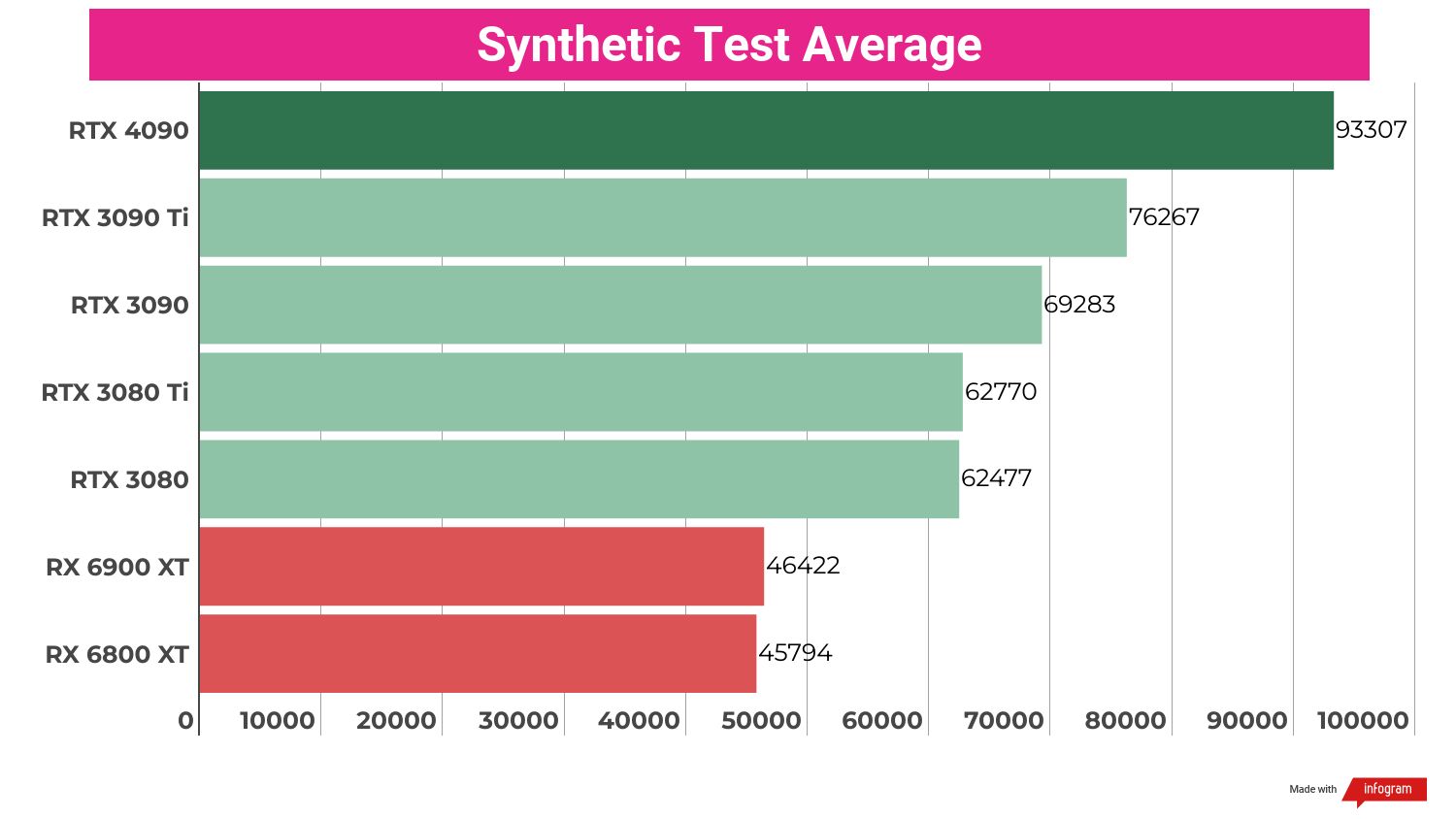

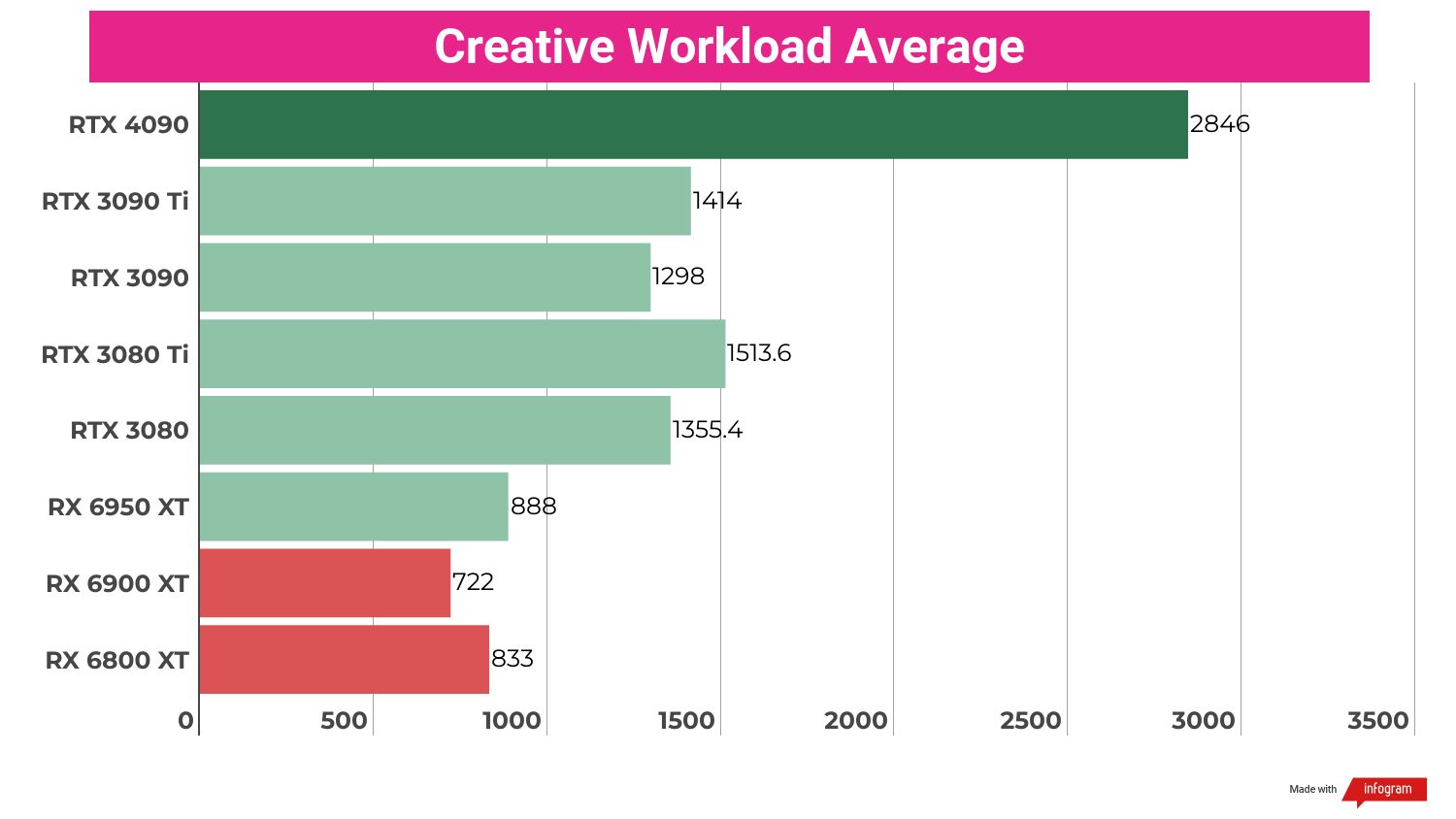





Across our synthetic benchmark tests, the Nvidia RTX 4090 produced eye-brow raising results from the jump, especially on more modern and advanced benchmarks like 3DMark Port Royal and Time Spy Extreme, occasionally fully lapping the RTX 3090 and running well ahead of the RTX 3090 Ti pretty much across the board.






This trend continues on to the GPU heavy creative benchmarks, with the Nvidia RTX 4090's Blender performance being especially noteable for more than doubling the RTX 3090 Ti's performance on two out of three tests, and blowing out any other competing 4K graphics card in Cycles rendering.
On Premiere Pro, the RTX 4090 scores noticeably higher than the RTX 3090 Ti, but the difference isn't nearly as dramatic since PugetBench for Premiere Pro measures full system performance rather than just isolating the GPU, and Adobe Photoshop is a heavily raterized workload, which is something that AMD has an advantage in over the past couple of generations, which is something we see pretty clearly in our tests.





Gaming is obviously going to see some of the biggest jumps in performance with the RTX 4090, and our tests bear that out. Most gaming benchmarks show roughly 90% to 100% improved framerates with the RTX 4090 over the RTX 3090, and roughly 55% to 75% better performance than the Nvidia RTX 3090 Ti.
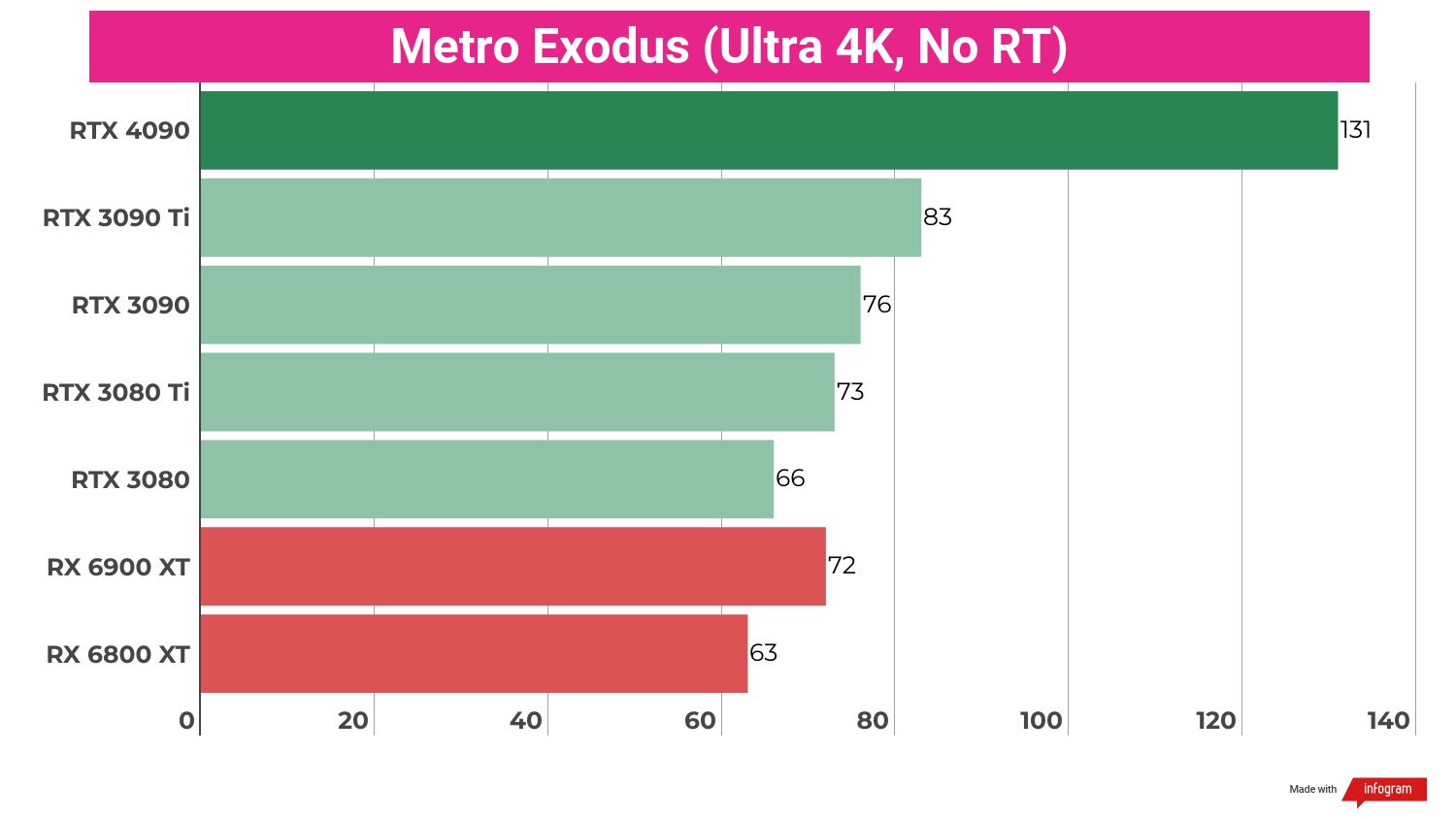
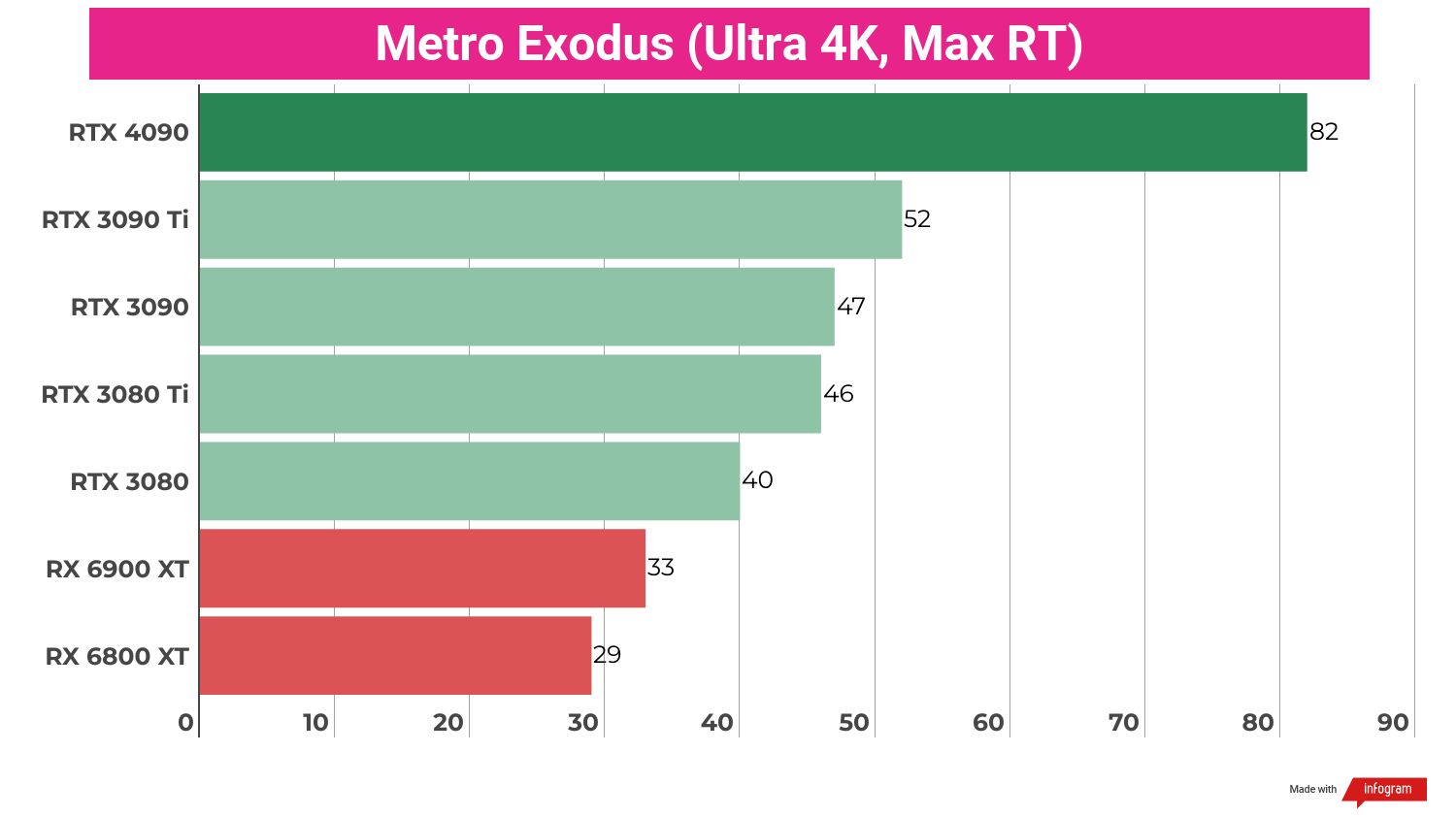


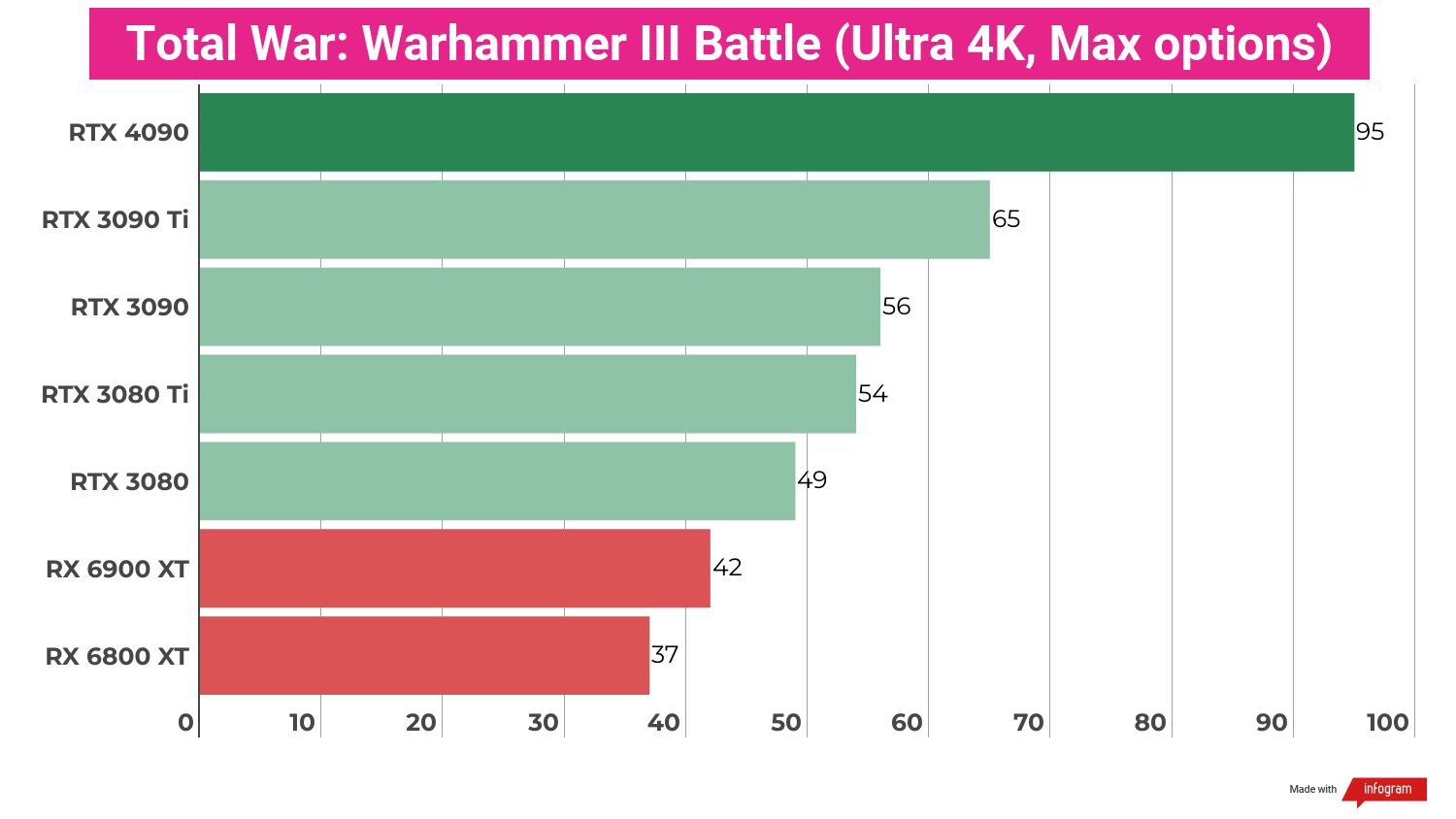








These numbers are likely to jump even higher when you factor in DLSS 3. DLSS 3 isn't available in any commercially available games yet, but we were able to test DLSS 3 on a couple of special builds games that will be available shortly after the release of the RTX 4090. A few of these games had in-game benchmarks that we could use to test the performance of DLSS 3 using Nvidia's FrameView tool and the results showed two to three times better performance on some games than we got using current builds on Steam with DLSS 2.0.
Since we were using special builds and Nvidia-provided tools, we can't necessarily declare these results representative until we are able to test them out on independent benchmarks, but just eyeballing the benchmark demos themselves we see an obvious improvement to the framerates of DLSS 3 over DLSS 2.0.
Whether the two to three times better performance will hold up after its official release remains to be seen, but as much as DLSS 2.0 revolutionized the performance of the best PC games, DLSS 3 looks to be just as game-changing once it gets picked up by developers across the PC gaming scene. Needless to say, AMD needs to step up its upscaling game if it ever hopes to compete on the high-end 4K scene.
Now, there is a real question about whether most gamers will ever need anything coming close to this kind of performance, and there is such a thing as diminishing returns. Some might find that the native 4K ray tracing is neat, but kind of redundant since DLSS can get you roughly the same experience with an RTX 3090 or even an RTX 3080 Ti, but that's a judgment that individual consumers are going to have to make.
Personally, I think this card is at least approaching the point of overkill, but there's no doubt that it overkills those frame rates like no other.
- Performance: 5 / 5
Should you buy an Nvidia GeForce RTX 4090?

Buy the Nvidia GeForce RTX 4090 if…
You want the best graphics card on the market
There really is no competition here. This is the best there is, plain and simple.
You want native 4K ray-traced gaming
DLSS and other upscaling tech is fantastic, but if you want native 4K ray-traced gaming, this is literally the only card that can consistently do it.
You are a 3D graphics professional
If you work with major 3D rendering tools like Maya, Blender, and the like, then this graphics card will dramatically speed up your workflows.
Don’t buy the Nvidia GeForce RTX 4090 if…
You're not looking to do native, max-4K gaming
Unless you're looking to game on the bleeding edge of graphical performance, you probably don't need this card.
You're on a budget
This is a very premium graphics card by any measure.
Also consider
Nvidia GeForce RTX 3090
The RTX 3090 isn't nearly as powerful as the RTX 4090, but it is still an amazing gaming and creative professional's graphics card and is likely to be very cheap right now.
Read the full Nvidia GeForce RTX 3090 review
Nvidia GeForce RTX 3080
The RTX 3080 is a far cry from the RTX 4090, no doubt, but the RTX 3080 currently has the best price to performance proposition of any 4K card on the market. If you're looking for the best value, the RTX 3080 is the clear winner here.
Read the full Nvidia GeForce RTX 3080 review
AMD Radeon RX 6950 XT
In another universe, AMD would have lead the Big Navi launch with the RX 6950 XT. It is a compelling gaming graphics card, offering excellent 4K gaming performance on par with the RTX 3090 and generally coming in at the same price as the RTX 3080 Ti.
Read the full AMD Radeon RX 6950 XT review
First reviewed in October 2022
Nvidia GeForce RTX 4090 Report Card
Value | While incredibly expensive, the performance gains make this luxury graphics card a downright bargain in comparison to the cards it is replacing | 4 / 5 |
Features & chipset | The next-gen Lovelace architecture introduces fully matured tensor and ray-tracing cores into the AD102 GPU. Faster clock speeds certainly don't hurt either. | 5 / 5 |
Design | The Founders Edition card isn't that much bigger than the RTX 3090, but it is heavier, so you'll likely need to invest in a GPU support bracket. Also, the 16-pin connector is going to challenge your cable management skills like nothing before. | 4 / 5 |
Performance | You're looking at double the performance of trhe RTX 3090 and up to 75% better performance than the RTX 3090 Ti, and that's not even factoring in what DLSS 3 will bring to the table. | 5 / 5 |
Total | Without a doubt, the Nvidia GeForce RTX 4090 is the best graphics card on the market, and it's hard to see what beats this. It runs laps around the RTX 3090 and does it for slightly more than its predecessor's MSRP. It is definitely for the enthusiasts out there, but it's unquestionably worth that enthusiasm. | 4.5 / 5 |

John (He/Him) is the Components Editor here at TechRadar and he is also a programmer, gamer, activist, and Brooklyn College alum currently living in Brooklyn, NY.
Named by the CTA as a CES 2020 Media Trailblazer for his science and technology reporting, John specializes in all areas of computer science, including industry news, hardware reviews, PC gaming, as well as general science writing and the social impact of the tech industry.
You can find him online on Bluesky @johnloeffler.bsky.social
You must confirm your public display name before commenting
Please logout and then login again, you will then be prompted to enter your display name.



